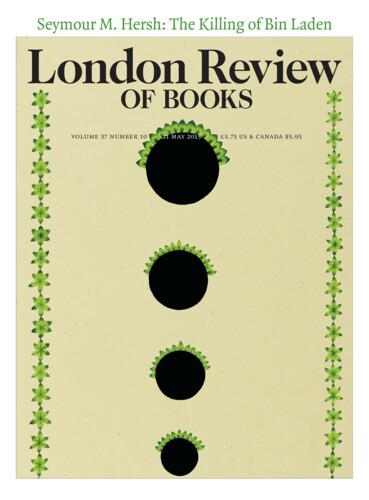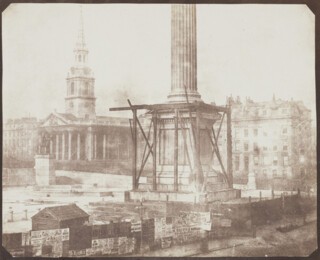How early was early photography? And how long did its earliness endure? The customary answer is just short of three decades, from about 1839 to 1865. The first date marks not the beginning of photographic experiments, but the year Louis Daguerre announced his ability to ‘seize the light’, a claim soon rephrased by William Henry Fox Talbot as the art of ‘fixing a shadow’. As for 1865, it’s the year that marks, along with much else, the assassination of Abraham Lincoln, the end of the American Civil War, and the inauguration of photography’s increasingly public role in the world. At war’s end Daguerre had been dead for 14 years. And Talbot had long since decided against renewing his patent on the talbotype (or more commonly, calotype) process, and begun to focus on deciphering cuneiform. When Talbot died in 1877, neither his calotype nor Daguerre’s daguerreotype was widely in use.
Daguerre seizes light, Talbot fixes shadow, and both echo principles shared with them by a third experimenter, the chemist and astronomer Sir John Herschel. It was Herschel who first used ‘negative’ and ‘positive’ to name the two distinct stages of photographic depiction, and Herschel whose investigations ultimately made it possible to capture the vagaries of light. In brief, what Herschel discovered was the role that solutions of salt and silver could play in seizing, or ‘fixing’, the otherwise elusive images produced when sunlight strikes a sensitised surface (Daguerre’s silver, Talbot’s paper). More or less any surface that could be treated with such solutions would do. From these discoveries comes Salt and Silver, the title of the exhibition at Tate Britain (until 7 June). The phrase evokes photography’s origin, but also conjures the distinctly domestic setting in which science was customarily practised two centuries ago. Talbot’s first subject was an oriel window in the abbey at Lacock where he and his family lived, and he found many other motifs both inside and out. There were the books on the shelves in his library, the contents (china and glassware) of the cupboards in the pantry, even the women’s marvellous hats. The hats figure in a picture which, though entitled The Milliner’s Window, was taken in the Lacock courtyard on improvised shelves. (From the beginning, photography was not the same as truth.) Also outdoors were huge oaks and elms and ivied arches and river reflections, a haystack and, famously, a doorway with a well-worn broom propped against a wall.
Talbot’s vision is Salt and Silver’s presiding force. His subjects are both personal and pictorial in an entirely new way. It’s as if he’d realised from the outset not just that he could make his world into a picture, but how. He had designed an easily portable camera, and was in the habit of taking it along on his travels. Oxford, Cambridge, London, Rouen, Paris: his pictures are small landmarks in the study of place. Salt and Silver allows close scrutiny of Nelson’s Column under Construction, Trafalgar Square (1844): start with the column itself, note how its bulky force seems to cede to the calm solidity of St Martin-in-the-Fields, how both structures dwarf Sir Francis Chantrey’s statue of George IV, and how the unfinished column, in extending out of frame, becomes the sign of a future to which, at least in this picture, neither crown nor church measures up. And then there’s the wooden hoarding that cuts diagonally along the lower edge. The column speaks to the future, but the hoarding and the advertisements plastered on it (‘Polkamania!!’ and ‘Natural Magic’ and ‘Forty Thieves’ sassily answer back to ‘No Bills to be Posted’), like the proto-constructivist scaffolding, invoke yet another temporality, that of the changing urban spectacle.
With daguerreotypes something else is at stake. The great majority are tightly framed portraits produced in a studio, not least because Daguerre’s process captured an excellent likeness for which middle-class sitters were eager to pay. The silver-coated copper on which the negative was fixed allowed a precision which, at this point, paper couldn’t match. Yet printing black on silver makes for an image that isn’t only expensive, but also difficult to see – one of many reasons why by the mid-1860s, silver-based negatives (as well as paper ones) had mostly yielded to glass.
The brief triumph of the paper negative is a key subtext of Salt and Silver, while daguerreotypes (which were produced in England and the US as well as France) figure not at all. This is how it should be. Beneath or behind each photo eventually printed by the method discovered at Lacock is a narrative of information transfer; a technological Tree of Jesse, with Talbot at its roots. As well as assembling his progeny, Salt and Silver demonstrates that what Talbot gave his heirs wasn’t merely a method. He seems to have grasped from the start the tension within photography’s great contrasts: he sees how to play positive against negative and how to bring out both surface and depth. Underpinning his images of hats and oaks and elms and china a strong sense of surface is always implicit. It stems from several sources: from Talbot’s love of grids and the pleasure he took in shadows, but also from the inherent softness of the washed paper he printed on which brought a seductive indistinctness to his pictures. The photographs made by later methods would never quite emulate the look of eager patience that calotypes convey: their absolute, even submissive willingness to wait for ‘reality’ to manifest itself, without being possessed of the ability to recognise how real it might be.
Salt and Silver traces the transformation of the photograph from indistinctness to clarity, though without passing over the work of the men who learned Talbot’s process and used it: the brilliant Scottish portraitists D.O. Hill and Robert Adamson, with their studies of Newhaven fisherfolk, the rather less gifted Rev. Calvert Jones, the Frenchman Louis-Désiré Blanquart-Evrard, who, though trained in chemistry, had to learn the elements of photography from a Lille chemist said to have worked with Talbot. From here, the process continued to spread: to Charles Marville, to Eugène Piot, to Auguste Salzmann. And other quite different genealogies developed alongside this one, as paper and glass-based processes started to be used in India and the US.
No one would bother to retrace these lineages without a reason. It’s to be found in the outline they provide of the spread of technological innovation, of knowledge gained, expanded, varied and passed on. Something of the same transformational process might be said to describe photographs too. At the beginning they travelled as both images and things, a fact too easily forgotten today, now that digital imagery can go viral without leaving the screen. Such unprecedented dematerialisation, while not entirely devaluing the photograph, does seem to make the ‘thingness’ of its 19th-century forebears more important than ever before. Today if ‘thingness’ matters, it is that of the screen. The picture snapped with a mobile may be charged with immediacy, but it lacks the power to reflect on the world it so eagerly, even promiscuously records. Or is it that the world ‘out there’ has somehow become invisible, little more than a background to the self?
Salt and Silver catalyses such reflections. Oddly enough, after each of my visits to Tate Britain, I went away with a sense of having been looking at, or into, a world so quiet I felt I was holding my breath. Not, of course, that noise can be ‘seen’. But pictures can convey it, and do. These early ones don’t. There is no rain, steam and speed on their horizons, not only because their processes couldn’t capture transience, but also because such effects didn’t yet matter to their work. There are no trains to be seen in the station at Amiens when Edouard Baldus was there in 1855, and none on the railway track that runs along the beach in South Devon Railway, Dawlish (1856) by J.W.G. Gutch. The Brady Studio’s Landing Supplies on the James River, Virginia (1863-64) was shot in a war zone regularly subject to Confederate sabotage; such a scene surely should be hectic, but only if you look very closely can you see the ghost of a horse-drawn wagon turning round.
If early photography is possessed of its own special sort of silence, it is also sombre, very often dramatic, and sometimes dour. It takes its energy from strong diagonals and stronger contrasts, and in the hands of many of its other gifted practitioners – Roger Fenton, or Baldus, or Salzmann again – manages to make such tensions serve as the compositional and conceptual axis of the work. Take The Floods of 1856, Brotteaux Quarter, Lyon, produced by Baldus at the behest of the French government, and one of the many commissioned photographs in the exhibition that signal how useful the new medium would prove to the powers that be. Yet mere usefulness is not what the image conveys. Against its unfocused foreground, the chaos of the scene seems all too familiar, and nearly complete: whole sides ripped from buildings, tiles and lumber scattered, here and there pieces of plaster or a leaning wheel. It is a picture that starts you searching the rubble for some elusive sign of life – or more likely, death. It may be this process that leads you to notice (tardily, if my case is typical) that there is water in this picture; the Rhône presumably, now mirror-like, its chaos gone.
It might be claimed that Baldus’s photograph is one of the more straightforwardly dramatic in the exhibition, but it seems to me that its real drama is more oblique, and lies in the quiet reflection offered as the aftermath of flood. I think it was this reversal that sent me back to Walter Benjamin’s essay, ‘A Little History of Photography’. For him, the force of 19th-century photographs lies in the vitality of their central contradiction: even though photographs are the products of ‘precise technology’, they are possessed of a ‘magical value’. But more than this, the fusion of precision and magic irresistibly provokes or inspires the viewer to search each image for the source of the magic. Once this happens, there is no forestalling the urge to seek out ‘the tiny spark of contingency, of the Here and Now, with which reality has so to speak seared the subject, to find the inconspicuous spot where in the immediacy of that long forgotten moment the future subsists so eloquently, that we, looking back, may rediscover it.’
I am not suggesting that Salt and Silver should be visited in order to seek out moments of contingency – to pin down this or that square inch where ‘reality’ appears. If anything, the exhibition succeeds in convincing us that this is not how photographic reality appears. It is not some ‘incident’ or ‘moment’ within a picture – this leaning broom or that glassy reflection, this train track or that turning wagon – that somehow gets through to us. If looking at Talbot’s Nelson’s Column or Baldus’s Rhône means asking the question of where or how their contingency is made present, these images themselves require us to recognise that no one answer will do. What these early photos remind us of is the mysteriousness of the ‘reality effect’. It often isn’t sharp and ‘punctual’: instead it seems to come out of a tightly wound opposition between light and shadow that inevitably leads to drama, but also to tension; remoteness, but also deathliness – as these photographers well knew. Perhaps this technical inevitability – the extremism of early photography – is the reason that Benjamin’s idea of reality unexpectedly ‘searing’ the subject of the photograph is so riveting. His phrase asks us to understand that the power of these images is their ability to spark conflagrations that transform the past.
Send Letters To:
The Editor
London Review of Books,
28 Little Russell Street
London, WC1A 2HN
letters@lrb.co.uk
Please include name, address, and a telephone number.


